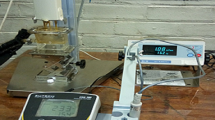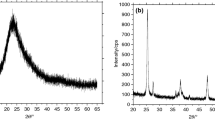Abstract
The present experimental analysis targeted on the preparation of water based (Al2O3-SiC-TiO2) ternary hybrid nanofluids by the mistreatment of two-stage methodology. Each vol. fraction sample of ternary hybrid nanofluids consists of an equal proportion of Al2O3-SiC-TiO2 nanoparticles for this analysis. The result for the dynamic viscosity of ternary hybrid nanofluids was examined for a temperature range of 35–40 °C and within a vol. fraction range of (0.01–0.1%). Analysis extended to the morphology characterization study through SEM image, together with an EDX analysis for 0.1% vol. fraction ternary hybrid nanofluid. Furthermore, based on the supported results, a new correlation was projected for the dynamic viscosity of ternary hybrid nanofluid, and also compared with the relevant literatures. The results revealed that the rise in vol. fraction, contains a larger role in increasing the interior resistance of fluid and the low vol. fractions have a weaker result on the viscosity of ternary hybrid nanofluids. The best relative consistency was discovered within 0.1% vol. fraction and, consistent with the obtained results, the margin of deviation within the intervals of ±2.6%.










Similar content being viewed by others
Abbreviations
- ϕ:
-
volume fraction
- ρ :
-
density
- w:
-
material weight
- μ:
-
dynamic viscosity
- bf:
-
base fluid
- Al2O3 :
-
aluminum oxide
- SiC:
-
silicon carbide
- TiO2 :
-
titanium oxide
- THNF:
-
ternary hybrid nanofluid
- SEM:
-
Scanning electron microscope
- EDX:
-
Energy Dispersive X-Ray
- MOD:
-
margin of deviation
- np:
-
nanoparticle
- T:
-
temperature
- Dp:
-
diameter of the nanoparticle
References
Haghighi EB, Utomo AT, Ghanbarpour M, Zavareh AIT, Nowak E, Khodabandeh R (2015) Combined effect of physical properties and convective heat transfer dynamic of nanofluids on their cooling efficiency., Int. Commun. Heat Mass Transf 68:32–42
Huminic G, Huminic A (2016) Heat transfer, and entropy generation analyses of nanofluids in helically coiled tube-in-tube heat exchangers. Int. Commun. Heat Mass Transf 71:118–125
Esfe MH, Saedodin S (2014) An experimental investigation and new correlation of viscosity of ZnO–EG nanofluid at various temperatures and different solid volume fractions. Exp Thermal Fluid Sci 55:1–5
Wongwises S, Dahari M (2016) Prediction of dynamic viscosity of a hybrid nano lubricant by an optimal artificial neural network. Int. Commun. Heat Mass Transf 76:209–214
Esfe MH, Rostamian H, Sarlak MR, Rejvani M, Alirezaie A (2017) Rheological behavior characteristics of TiO2-MWCNT/10w40 hybrid nano-oil affected by temperature, concentration and shear rate: an experimental study and a neural network simulating. Phys E 94:231–240
Esfe MH, Saedodin S, Rejvani M, Shahram J (2017) Experimental investigation, model development, and sensitivity analysis of rheological behavior of ZnO/10W40 nano-lubricants for automotive applications. Phys E 90:194–203
Bergles AE (1998) Techniques to enhance heat transfer. In handbook of heat transfer, 3rd ed., McGraw-hill, New York, Chap. 11
De A, Noni J, Garcia DE, Hotza D (2002) A modified model for the viscosity of ceramic suspensions. Ceram Int 28(7):731–735
Keblinski P, Eastman JA, Cahill DG (2005) Nanofluids for thermal transport. Mater.Today 8(6):36–44
Namburu PK, Das DK, Tanguturi KM, Vajjha RS (2009) Numerical study of turbulent flow and heat transfer characteristics of nanofluids considering variable properties. Int J Therm Sci 48(2):290–302
Jumpholkul C, Mahian O, Kasaeian A, Dalkilic AS, Wongwises S (2017) An experimental study to determine the maximum efficiency index in turbulent flow of SiO2/water nanofluids. Int J Heat Mass Transf 112:1113–1121
Nguyen C, Desgranges F, Galanis N, Roy G, Marc T, Boucherb S, Mintsa HA (2008) Viscosity data for Al2O3-water nanofluid-hysteresis: is heat transfer enhancement using nanofluids reliable, Int. J Therm Sci 47(2):103–111
Vajjha RS (2008) Measurements of Thermophysical properties of Nanofluids and computation of heat transfer characteristics. M.S. thesis, Mech. Engineering Dept., University of Alaska Fairbanks, Fairbanks
Das SK, Putra N, Thiesen P, Roetzel W (2003) Temperature dependence of thermal conductivity enhancement for nanofluids, J. Heat Transfer 125(4):567–574
Anoop K, Kabelac S, Sundararajan T, Das SK (2009) Rheological and flow characteristics of nanofluids: influence of electroviscous effects and particle agglomeration. J Appl Phys 106(3):907–909
Kao MJ, Chang H, Wu YY, Tsung TT, Lin HM (2007) Producing aluminum oxide brake nanofluids using plasma charging system. J Chin Soc Mech Eng 28(2):123–131
Sepyani K, Afrand M, Esfe MH (2017) An experimental evaluation of the effect of ZnO nanoparticles on the rheological behavior of engine oil. J Mol Liq 236:198–204
Anoop KB, Sundararajan T, Das SK (2009) Effect of particle size on the convective heat transfer in nanofluid in the developing region. Int J Heat Mass Transf 52:2189–2195
Duangthongsuk W, Wongwises S (2009) Measurement of temperature-dependent thermal conductivity and viscosity of TiO2–water nanofluids. Exp Thermal Fluid Sci 33:706–714
Namburu PK, Kulkarni DP, Misra D, Das DK (2007) Viscosity of copper oxide nanoparticles dispersed in ethylene glycol and water mixture. Exp Thermal Fluid Sci 32(2):397–402
Prasher R, Song D, Wang J, Phelan P (2006) Measurements of nanofluid viscosity and its implications for thermal applications. Appl Phys Lett 89(13):103–108
Chen H, Ding Y, He Y, Tan C (2007) Rheological behavior of ethylene glycol-based titania nanofluids, Chem Phys Lett 444 (4):333–337
Putra N, Roetzel W, Das SK (2003) Natural convection of nanofluids. Heat Mass Transf 39:8–9
Wen D, Lin G, Vafaei S, Zhang K (2009) Review of nanofluids for heat transfer applications. Particuology 7(2):141–150
Namburu PK, Kulkarni DP, Dandekar A, Das DK (2007) Experimental investigation of viscosity and specific heat of silicon dioxide nanofluids. Micro Nano Lett, IET 2(3):67–71
Mosavian MTH, Heris SZ, Etemad SG, Esfahany MN (2010) Heat transfer enhancement by application of nano-powder. J Nanopart Res 12:2611–2619
Garg J, Poudel B, Chiesa M, Gordon JB, Ma JJ, Wang JB, Ren ZF, Kang Y.T, Ohtani H, Nanda J, McKinley GH, Chen G (2008) Enhanced thermal conductivity and viscosity of copper nanoparticles in ethylene glycol nanofluid. J ApplPhys 103074301
Behi M, Mirmohammadi SA (2012) Investigation on thermal conductivity, viscosity, and stability of nanofluids (master of science thesis), RoyalInstitute of technology (KTH). Stockholm, Sweden
Esfe MH, Saedodin S, Wongwises S, Toghraie D (2015) An experimental study on the effect of diameter on thermal conductivity and dynamic viscosity of Fe/water nanofluids. J Therm Anal Calorim 119:1817–1824
Pak BC, Cho YI (1998) Hydrodynamic, and heat transfer study of dispersed fluids with submicron metallic oxide particles. Experimental heat transfer an. Int J 11(2):151–170
Brinkman HC (1952) The viscosity of concentrated suspensions and solutions. J ChemPhys 20(4):571
Einstein A (1956) Investigations on the theory of the Brownian movement. Corporation, Courier
Batchelor GK (1977) The effect of Brownian motion on the bulk stress in a suspension of spherical particles, J. Fluid Mech 83(1):97–117
Chen H, Ding Y, He Y, Tan (2007) Rheological behavior of ethylene glycol-based titania nanofluids. Chem Phys Lett 444(4–6):333–337
Yao J, Han H, Hou Y, Gong E, Yin W (2016) A method of calculating the interaction energy between particles in minerals flotation. Mathematical Problems in Engineering, Article ID 8430745:1–13
Yiamsawas T, Mahian O, Dalkilic AS, Kaewnai S, Wongwises S (2013) Experimental studies on the viscosity of TiO2 and Al2O3 nanoparticles suspended in a mixture of ethylene glycol and water for high- temperature applications. Appl Energy 111:40–45
Dalkilic AS, Küçükyıldırım BO, Eker AA, Çeb A, Tapan S, Jumpholkul C, Wongwises S (2017) Experimental investigation on the viscosity of water-CNT and antifreeze-CNT nanofluids. International Communications in Heat and Mass Transfer 80:47–59
Recktenwald G (2006) Uncertainty Estimation and Calculation, www.me.pdx.edu/~gerry/class/ME449
Author information
Authors and Affiliations
Corresponding author
Additional information
Publisher’s note
Springer Nature remains neutral with regard to jurisdictional claims in published maps and institutional affiliations.
Rights and permissions
About this article
Cite this article
Sahoo, R.R. Experimental study on the viscosity of hybrid nanofluid and development of a new correlation. Heat Mass Transfer 56, 3023–3033 (2020). https://doi.org/10.1007/s00231-020-02915-9
Received:
Accepted:
Published:
Issue Date:
DOI: https://doi.org/10.1007/s00231-020-02915-9




